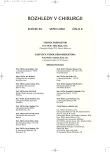Endoscopic Radial Artery Harvesting for Coronary Artery Bypass Grafting: First Experience
Authors:
M. Šimek; P. Marcián; V. Bruk; P. Němec; M. Gwozdziewicz
Authors‘ workplace:
Němec, CSc.
; Kardiochirurgická klinika FN a LF Univerzity Palackého v Olomouci, přednosta: doc. MUDr. P.
Published in:
Rozhl. Chir., 2006, roč. 85, č. 8, s. 416-422.
Category:
Monothematic special - Original
Overview
Background:
Radial artery is widely accepted for surgical myocardial revascularization due to reported better long-term patency than venous grafts. Endoscopic radial artery harvesting (ERAH) represents a modern method associated with reduction of post-harvesting complications in comparison with the traditional radial artery harvesting.
Methods:
From October 2005 to March 2006, ERAH was performed in a group of 10 patients employing the Vasoview 6™ system (Guidant, Europe S.A., Belgium). Patients were evaluated on 7th postoperative day for wound healing disturbances and neurological complications.
Results:
The mean age was 62.7 ± 11.3 years, male patients dominated (60%) and 5 patients (50%) suffered from diabetes. All 10 radial arteries were successfully harvested, no conduit was injured. No conversions were made from ERAH to traditional technique. The mean harvesting time was 44.9 ± 8.2 min (range: 32–62) and the mean time of forearm ischemia was 56.7 ± 9.3 min (range: 42–74). The mean length of the grafts was 20.3 ± 2.2 cm. The small local haematoma was recorded in one patient (10%). Neither wound disturbances such as wound infection, wound dehiscence, skin necrosis, nor neurological complications were recorded in our group of patients.
Conclusion:
ERAH is a safe method associated with a significant reduction of particularly neurological complications associated with traditional radial artery harvest. Full-length radial artery conduits were obtained with improved cosmetic result and patient’s satisfaction.
Labels
Surgery Orthopaedics Trauma surgeryArticle was published in
Perspectives in Surgery

2006 Issue 8
Most read in this issue
- Neovascularisation as a Cause of Recurrence after Varicose Veins Operation
- Cavernous Haemangioma of the Small Intestine Leading to Haemoperitoneum
- Clinical Significance of Venoplasties in Infragenicular Prosthetic Bypass Grafts
- SIRS and Serious Blunt Injuries
